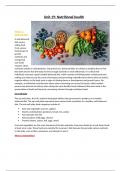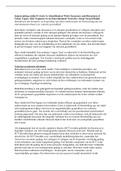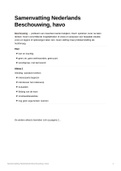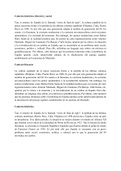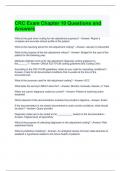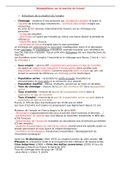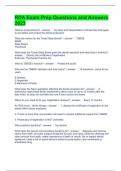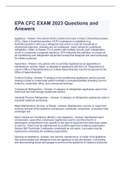Contents- GLOBAL BANKING 2023-2024
1. Chapter 1: What is special about banking? ..................................................................................... 5
1. Introduction ................................................................................................................................. 5
2. The nature of financial intermediation ........................................................................................ 5
2.1. Direct Finance versus Financial Intermediation .................................................................. 5
2.2. Recent evolutions ................................................................................................................ 5
3. The role of banks ......................................................................................................................... 5
3.1. Size ...................................................................................................................................... 5
3.2. Maturity ............................................................................................................................... 5
3.3. Risk...................................................................................................................................... 6
4. Information economics ................................................................................................................ 6
4.1. Asymmetric information ..................................................................................................... 6
4.2. Relationship Banking versus Transaction Banking ............................................................. 6
5. Why do banks exist?.................................................................................................................... 6
5.1. Delegated monitoring – information asymmetry + transaction costs .................................. 6
5.2. Information production – (information asymmetry) + transaction costs ............................. 7
5.3. Liquidity transformation...................................................................................................... 7
5.4. Consumption smoothing...................................................................................................... 7
5.5. Commitment mechanisms ................................................................................................... 7
6. The benefits of financial intermediation...................................................................................... 7
6.1. Lenders ................................................................................................................................ 7
6.2. Borrowers ............................................................................................................................ 7
6.3. Society as a whole ............................................................................................................... 7
Chapter 2: Bank activities and services ................................................................................................... 8
1. What do banks do? ...................................................................................................................... 8
2. Banks and other financial institutions ......................................................................................... 8
2.1 Discretionary deposits versus Contractual funds................................................................. 8
2.2 Universal banking................................................................................................................ 8
3. Banking services.......................................................................................................................... 8
2.1 Payment services ................................................................................................................. 8
2.2 Deposits and lending services ............................................................................................. 9
2.3 Other financial services - Investment, pensions and insurance services ............................. 9
2.4 Trade finance and cross border finance ............................................................................... 9
4. Banks and the Fintech revolution .............................................................................................. 10
4.1 What is fintech................................................................................................................... 10
4.2 What is bigtech .................................................................................................................. 10
4.3 Possible Scenarios for the fintech revolution .................................................................... 10
,Chapter 3: types of banks ...................................................................................................................... 11
1. Introduction ............................................................................................................................... 11
2. Evolution of banking ................................................................................................................. 11
2.1. EU versus USA until 1992 ................................................................................................ 11
2.2. The Second European Banking Directive ......................................................................... 11
2.3. Impact of the Second European Banking Directive in the USA ....................................... 12
3. The banking landscape .............................................................................................................. 13
3.1 By the client base they serves ............................................................................................ 13
3.2 The type of the services they provide ................................................................................ 13
3.3 By their ownership structure ............................................................................................. 13
4. End of the investment banks...................................................................................................... 13
4.1. Deregulation of the 1990’s ................................................................................................ 13
4.2. Financial crisis ................................................................................................................... 13
4.3. Bank Holding Company .................................................................................................... 13
CHAPTER 9: BANKS BALANCE SHEET AND INCOME STRUCTURE ...................................... 14
1. Introduction ............................................................................................................................... 14
2. Retail banks’ financial statements ............................................................................................. 14
2.1 Balance Sheet Retail – assets & liabilities......................................................................... 14
2.2 Income statement Retail .................................................................................................... 16
3. Investment banks’ financial statements ..................................................................................... 17
3.1. Balance sheet Investment Banks ....................................................................................... 17
3.2. Income statement - Investment Banks .............................................................................. 17
4. Bank performance and financial ratio analysis.......................................................................... 18
4.1. Introduction – Stakeholders ............................................................................................... 18
4.2. Profitability ratio’s............................................................................................................. 19
4.3. Other profitability ratio’s ................................................................................................... 20
4.4. Asset quality ...................................................................................................................... 21
4.5. Non-performing loans ....................................................................................................... 22
5. Cost of Capital and shareholder value creation ......................................................................... 23
5.1. Introduction – Equity value ............................................................................................... 23
5.2. Cost of Capital ................................................................................................................... 23
5.3. Economic value added and risk-adjusted return ................................................................ 24
CAPITAL REQUIREMENTS – Part 1 ................................................................................................. 27
2.1 Introduction – Regulation – systematic risk – deposit insurance – cap req........................... 27
1.1 Does the banking sector self-regulate? .............................................................................. 27
1.2 Systematic risk? ................................................................................................................. 27
1.3 Deposit insurance .............................................................................................................. 27
, 1.4 Capital requirements .......................................................................................................... 27
2.2 Basel Committee ................................................................................................................... 28
2.3 History of banking regulation ................................................................................................ 28
2.3.1. Pre-1988 ........................................................................................................................ 28
2.3.2. 1988: BIS Accord (Basel I) ........................................................................................... 28
2.3.3. Capital requirements under Basel 1 ............................................................................... 29
2.3.4. Types of available capital under Basel I ........................................................................ 29
2.3.5. Risk weighted asset for credit risk................................................................................. 30
2.3.6. Final formula ................................................................................................................. 31
2.3.7. 1996: Amendment to BIS Accord – netting – market risk ............................................ 32
CAPITAL REQUIREMENTS: Part 2 ................................................................................................... 35
1. Introduction – Basel II - 2008 .................................................................................................. 35
2. The three Pillars......................................................................................................................... 35
2.1 Basel 1 vs Basel 2 .............................................................................................................. 35
2.2. Pilar 2 ..................................................................................................................................... 36
2.3. Pilar 2 – ICAAP ..................................................................................................................... 37
2.3. Pillar 3 – Market Discipline ................................................................................................... 37
3. Pillar I: Overview ...................................................................................................................... 39
3.1. Main changes compared to Basel I .................................................................................... 39
3.2. Types of Risks ................................................................................................................... 40
3.3. Minimum capital requirements – credit – market – operational........................................ 40
3.4. Minimum capital requirements - Credit risk - Standardized ............................................. 41
3.5. Pillar 1: IRB APPROACH FOR CREDIT RISK .............................................................. 43
3.6. Pillar 1 – RWA .................................................................................................................. 47
....................................................................................................................................................... 47
4. Elements that make Basel II more risk sensitive ....................................................................... 48
The Financial Crisis of 2007 – 2008 ..................................................................................................... 49
1. Asset-backed securities ............................................................................................................. 49
1.2. The waterfall...................................................................................................................... 50
2. CDO = Collateralized debt obligations ..................................................................................... 50
3. How the crisis came about ......................................................................................................... 51
3.1 Real estate prices ............................................................................................................... 51
3.2 How it started .................................................................................................................... 52
3.3 Later on.............................................................................................................................. 52
3.4 When the bubble did burst ................................................................................................. 53
4. The importance of dependence .................................................................................................. 53
5. The effect of correlation on CDO – tranches – Example .......................................................... 54
,6. The concept of cliff risk ............................................................................................................ 55
7. Lessons learned ......................................................................................................................... 55
, 1. Chapter 1: What is special about banking?
1. Introduction
2. The nature of financial intermediation
- Why when do people/companies borrow money?
Borrowers are short on cash, they have a positive economic value (they are expected to generate profit
in the future, else they wouldn’t have been given a loan in the first place), they are liquidity constraint
(cannot sell part of their assets because they are illiquid)
- Borrowers Requirements versus Lenders Requirements → Conflict
Borrowers Lenders
Minimize costs Minimize costs
Funds at a specific date Minimize risk (default risk especially) + risk of
asset (loan) decreasing in value over time (future
is uncertain)
Repayment over a specific time Liquidity (ability to convert an asset (loan) back
into cash without incurring a loss in value or costs
2.1.Direct Finance versus Financial Intermediation
Direct financing = matches deficit -and surplus units 1 on 1. There is still some type of financial
intermediation (investment banks) – but the funds are raised directly from the market, NOT from the
intermediary.
Issues: (1. Incompatibility of matching due to different needs and preferences. 2. Costly
and difficult to match)
Financial intermediation = pools the different deposits into 1 pool and matches this with deficit units.
It solves the problems of direct financing, as it does not necessarily matches 1 on 1. The costs of
matching decreases = Economies of Scale.
Issues: (1. high information asymmetry leads to substantial transaction costs due to: -
negotiation of loans, assessing of clients, monitoring borrowers, recovery in case of
defaults)
2.2.Recent evolutions
- Securitization = banks convert illiquid assets on their B.S. into tradeable financial instruments
(e.g. bonds/notes issued by investors)
- Shadow banking = credit intermediation involving entities and activities outside of banking
system → creates unfair competition towards banks as they aren’t regulated and possibly poses
instability in the financial system
3. The role of banks
Banks are able to match lenders with borrowers by performing a transformation function.
3.1.Size
By pooling together many different deposits (typically smaller than the demand of depositors) they can
enjoy economies of scale as they now can give larger loans. – no 1 on 1 matching
3.2.Maturity
Banks convert the demand deposits into medium long term loans: they borrow short and lend long →
mismatch between assets and liabilities. → liquidity risk (risk of not having sufficient liquid funds when
demanded.)
, 3.3.Risk
Banks can decrease the risk of default of individuals impacting them by diversifying over many different
clients, by monitoring and screening and, by holding excess capital.
4. Information economics
4.1. Asymmetric information
Banks enjoy economies of scale and therefore TC are lower than the TC with direct financing!
= 2 sides (both banks as clients don’t have all information)
- Everyone has less than perfect information
- Not everyone has access to the same information
- Some have inside information that isn’t available to both parties
Banks transform primary securities (loans) into secondary securities (bank accounts)
A. Adverse Selection = ex ante issue
➔ Solve: screening + loan pricing
➔ Adverse selection is an “ex ante” issue. It exists before the transactions has occurred. It
might even be the reason why no transaction occurs at all.
➔ Creditors in financial difficulties are in more need of loans than others but are also more
likely to default
➔ Banks tend to attract the wrong type of clients
By raising interest rates = loan pricing you would expect creditors with a weak financial situation to
back off but the opposite is true, since they are in such need they are willing to take the risk. Until a
certain point banks can raise interest rates with their expected return increasing, but until a certain point
banks cannot raise interest rates any longer as then good creditors will not apply anymore (since they
aren’t in such high needs) and therefore only the bad lenders will try to have a loan, and the expected
return for banks will decrease again.
B. Moral hazard = Post ante issue → Solve: monitoring
= risk that 1 party in a transaction behaves in a way that is against the interest of the other party after the
contract has been concluded. → lack of incentive to guard against the risks because 1 party is protected
from the consequences.
4.2.Relationship Banking versus Transaction Banking
Relationship = more EU → LT-relationship: decreases TC + decreases adverse selection and moral
hazard
VERSUS
Transaction = no LT → banks issue loans and instead of putting them on their Balance Sheet, they pool
them and through a SPV they issue securities. → less incentives for monitoring and screening = bad
5. Why do banks exist?
5.1.Delegated monitoring – information asymmetry + transaction costs
Lenders delegate the authority of screening and monitoring to banks because they enjoy economies of
scale (pool deposits together) and therefore have lower transaction costs than with direct financing that
arise from information asymmetry.
Banks can also diversify their credit risk over a larger portfolio, reaching larger levels of diversification
than an individual.
1. Chapter 1: What is special about banking? ..................................................................................... 5
1. Introduction ................................................................................................................................. 5
2. The nature of financial intermediation ........................................................................................ 5
2.1. Direct Finance versus Financial Intermediation .................................................................. 5
2.2. Recent evolutions ................................................................................................................ 5
3. The role of banks ......................................................................................................................... 5
3.1. Size ...................................................................................................................................... 5
3.2. Maturity ............................................................................................................................... 5
3.3. Risk...................................................................................................................................... 6
4. Information economics ................................................................................................................ 6
4.1. Asymmetric information ..................................................................................................... 6
4.2. Relationship Banking versus Transaction Banking ............................................................. 6
5. Why do banks exist?.................................................................................................................... 6
5.1. Delegated monitoring – information asymmetry + transaction costs .................................. 6
5.2. Information production – (information asymmetry) + transaction costs ............................. 7
5.3. Liquidity transformation...................................................................................................... 7
5.4. Consumption smoothing...................................................................................................... 7
5.5. Commitment mechanisms ................................................................................................... 7
6. The benefits of financial intermediation...................................................................................... 7
6.1. Lenders ................................................................................................................................ 7
6.2. Borrowers ............................................................................................................................ 7
6.3. Society as a whole ............................................................................................................... 7
Chapter 2: Bank activities and services ................................................................................................... 8
1. What do banks do? ...................................................................................................................... 8
2. Banks and other financial institutions ......................................................................................... 8
2.1 Discretionary deposits versus Contractual funds................................................................. 8
2.2 Universal banking................................................................................................................ 8
3. Banking services.......................................................................................................................... 8
2.1 Payment services ................................................................................................................. 8
2.2 Deposits and lending services ............................................................................................. 9
2.3 Other financial services - Investment, pensions and insurance services ............................. 9
2.4 Trade finance and cross border finance ............................................................................... 9
4. Banks and the Fintech revolution .............................................................................................. 10
4.1 What is fintech................................................................................................................... 10
4.2 What is bigtech .................................................................................................................. 10
4.3 Possible Scenarios for the fintech revolution .................................................................... 10
,Chapter 3: types of banks ...................................................................................................................... 11
1. Introduction ............................................................................................................................... 11
2. Evolution of banking ................................................................................................................. 11
2.1. EU versus USA until 1992 ................................................................................................ 11
2.2. The Second European Banking Directive ......................................................................... 11
2.3. Impact of the Second European Banking Directive in the USA ....................................... 12
3. The banking landscape .............................................................................................................. 13
3.1 By the client base they serves ............................................................................................ 13
3.2 The type of the services they provide ................................................................................ 13
3.3 By their ownership structure ............................................................................................. 13
4. End of the investment banks...................................................................................................... 13
4.1. Deregulation of the 1990’s ................................................................................................ 13
4.2. Financial crisis ................................................................................................................... 13
4.3. Bank Holding Company .................................................................................................... 13
CHAPTER 9: BANKS BALANCE SHEET AND INCOME STRUCTURE ...................................... 14
1. Introduction ............................................................................................................................... 14
2. Retail banks’ financial statements ............................................................................................. 14
2.1 Balance Sheet Retail – assets & liabilities......................................................................... 14
2.2 Income statement Retail .................................................................................................... 16
3. Investment banks’ financial statements ..................................................................................... 17
3.1. Balance sheet Investment Banks ....................................................................................... 17
3.2. Income statement - Investment Banks .............................................................................. 17
4. Bank performance and financial ratio analysis.......................................................................... 18
4.1. Introduction – Stakeholders ............................................................................................... 18
4.2. Profitability ratio’s............................................................................................................. 19
4.3. Other profitability ratio’s ................................................................................................... 20
4.4. Asset quality ...................................................................................................................... 21
4.5. Non-performing loans ....................................................................................................... 22
5. Cost of Capital and shareholder value creation ......................................................................... 23
5.1. Introduction – Equity value ............................................................................................... 23
5.2. Cost of Capital ................................................................................................................... 23
5.3. Economic value added and risk-adjusted return ................................................................ 24
CAPITAL REQUIREMENTS – Part 1 ................................................................................................. 27
2.1 Introduction – Regulation – systematic risk – deposit insurance – cap req........................... 27
1.1 Does the banking sector self-regulate? .............................................................................. 27
1.2 Systematic risk? ................................................................................................................. 27
1.3 Deposit insurance .............................................................................................................. 27
, 1.4 Capital requirements .......................................................................................................... 27
2.2 Basel Committee ................................................................................................................... 28
2.3 History of banking regulation ................................................................................................ 28
2.3.1. Pre-1988 ........................................................................................................................ 28
2.3.2. 1988: BIS Accord (Basel I) ........................................................................................... 28
2.3.3. Capital requirements under Basel 1 ............................................................................... 29
2.3.4. Types of available capital under Basel I ........................................................................ 29
2.3.5. Risk weighted asset for credit risk................................................................................. 30
2.3.6. Final formula ................................................................................................................. 31
2.3.7. 1996: Amendment to BIS Accord – netting – market risk ............................................ 32
CAPITAL REQUIREMENTS: Part 2 ................................................................................................... 35
1. Introduction – Basel II - 2008 .................................................................................................. 35
2. The three Pillars......................................................................................................................... 35
2.1 Basel 1 vs Basel 2 .............................................................................................................. 35
2.2. Pilar 2 ..................................................................................................................................... 36
2.3. Pilar 2 – ICAAP ..................................................................................................................... 37
2.3. Pillar 3 – Market Discipline ................................................................................................... 37
3. Pillar I: Overview ...................................................................................................................... 39
3.1. Main changes compared to Basel I .................................................................................... 39
3.2. Types of Risks ................................................................................................................... 40
3.3. Minimum capital requirements – credit – market – operational........................................ 40
3.4. Minimum capital requirements - Credit risk - Standardized ............................................. 41
3.5. Pillar 1: IRB APPROACH FOR CREDIT RISK .............................................................. 43
3.6. Pillar 1 – RWA .................................................................................................................. 47
....................................................................................................................................................... 47
4. Elements that make Basel II more risk sensitive ....................................................................... 48
The Financial Crisis of 2007 – 2008 ..................................................................................................... 49
1. Asset-backed securities ............................................................................................................. 49
1.2. The waterfall...................................................................................................................... 50
2. CDO = Collateralized debt obligations ..................................................................................... 50
3. How the crisis came about ......................................................................................................... 51
3.1 Real estate prices ............................................................................................................... 51
3.2 How it started .................................................................................................................... 52
3.3 Later on.............................................................................................................................. 52
3.4 When the bubble did burst ................................................................................................. 53
4. The importance of dependence .................................................................................................. 53
5. The effect of correlation on CDO – tranches – Example .......................................................... 54
,6. The concept of cliff risk ............................................................................................................ 55
7. Lessons learned ......................................................................................................................... 55
, 1. Chapter 1: What is special about banking?
1. Introduction
2. The nature of financial intermediation
- Why when do people/companies borrow money?
Borrowers are short on cash, they have a positive economic value (they are expected to generate profit
in the future, else they wouldn’t have been given a loan in the first place), they are liquidity constraint
(cannot sell part of their assets because they are illiquid)
- Borrowers Requirements versus Lenders Requirements → Conflict
Borrowers Lenders
Minimize costs Minimize costs
Funds at a specific date Minimize risk (default risk especially) + risk of
asset (loan) decreasing in value over time (future
is uncertain)
Repayment over a specific time Liquidity (ability to convert an asset (loan) back
into cash without incurring a loss in value or costs
2.1.Direct Finance versus Financial Intermediation
Direct financing = matches deficit -and surplus units 1 on 1. There is still some type of financial
intermediation (investment banks) – but the funds are raised directly from the market, NOT from the
intermediary.
Issues: (1. Incompatibility of matching due to different needs and preferences. 2. Costly
and difficult to match)
Financial intermediation = pools the different deposits into 1 pool and matches this with deficit units.
It solves the problems of direct financing, as it does not necessarily matches 1 on 1. The costs of
matching decreases = Economies of Scale.
Issues: (1. high information asymmetry leads to substantial transaction costs due to: -
negotiation of loans, assessing of clients, monitoring borrowers, recovery in case of
defaults)
2.2.Recent evolutions
- Securitization = banks convert illiquid assets on their B.S. into tradeable financial instruments
(e.g. bonds/notes issued by investors)
- Shadow banking = credit intermediation involving entities and activities outside of banking
system → creates unfair competition towards banks as they aren’t regulated and possibly poses
instability in the financial system
3. The role of banks
Banks are able to match lenders with borrowers by performing a transformation function.
3.1.Size
By pooling together many different deposits (typically smaller than the demand of depositors) they can
enjoy economies of scale as they now can give larger loans. – no 1 on 1 matching
3.2.Maturity
Banks convert the demand deposits into medium long term loans: they borrow short and lend long →
mismatch between assets and liabilities. → liquidity risk (risk of not having sufficient liquid funds when
demanded.)
, 3.3.Risk
Banks can decrease the risk of default of individuals impacting them by diversifying over many different
clients, by monitoring and screening and, by holding excess capital.
4. Information economics
4.1. Asymmetric information
Banks enjoy economies of scale and therefore TC are lower than the TC with direct financing!
= 2 sides (both banks as clients don’t have all information)
- Everyone has less than perfect information
- Not everyone has access to the same information
- Some have inside information that isn’t available to both parties
Banks transform primary securities (loans) into secondary securities (bank accounts)
A. Adverse Selection = ex ante issue
➔ Solve: screening + loan pricing
➔ Adverse selection is an “ex ante” issue. It exists before the transactions has occurred. It
might even be the reason why no transaction occurs at all.
➔ Creditors in financial difficulties are in more need of loans than others but are also more
likely to default
➔ Banks tend to attract the wrong type of clients
By raising interest rates = loan pricing you would expect creditors with a weak financial situation to
back off but the opposite is true, since they are in such need they are willing to take the risk. Until a
certain point banks can raise interest rates with their expected return increasing, but until a certain point
banks cannot raise interest rates any longer as then good creditors will not apply anymore (since they
aren’t in such high needs) and therefore only the bad lenders will try to have a loan, and the expected
return for banks will decrease again.
B. Moral hazard = Post ante issue → Solve: monitoring
= risk that 1 party in a transaction behaves in a way that is against the interest of the other party after the
contract has been concluded. → lack of incentive to guard against the risks because 1 party is protected
from the consequences.
4.2.Relationship Banking versus Transaction Banking
Relationship = more EU → LT-relationship: decreases TC + decreases adverse selection and moral
hazard
VERSUS
Transaction = no LT → banks issue loans and instead of putting them on their Balance Sheet, they pool
them and through a SPV they issue securities. → less incentives for monitoring and screening = bad
5. Why do banks exist?
5.1.Delegated monitoring – information asymmetry + transaction costs
Lenders delegate the authority of screening and monitoring to banks because they enjoy economies of
scale (pool deposits together) and therefore have lower transaction costs than with direct financing that
arise from information asymmetry.
Banks can also diversify their credit risk over a larger portfolio, reaching larger levels of diversification
than an individual.

